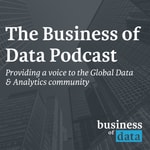The Business of Data Podcast – Details, episodes & analysis
Podcast details
Technical and general information from the podcast's RSS feed.

The Business of Data Podcast
Business of Data by Corinium
Frequency: 1 episode/12d. Total Eps: 132

Recent rankings
Latest chart positions across Apple Podcasts and Spotify rankings.
Apple Podcasts
🇬🇧 Great Britain - techNews
19/07/2025#97🇬🇧 Great Britain - techNews
18/07/2025#83🇬🇧 Great Britain - techNews
17/07/2025#58🇬🇧 Great Britain - techNews
16/07/2025#39🇬🇧 Great Britain - techNews
27/11/2024#86🇬🇧 Great Britain - techNews
26/11/2024#72🇬🇧 Great Britain - techNews
25/11/2024#52
Spotify
No recent rankings available
Shared links between episodes and podcasts
Links found in episode descriptions and other podcasts that share them.
See all- https://ukcop26.org/
57 shares
RSS feed quality and score
Technical evaluation of the podcast's RSS feed quality and structure.
See allScore global : 42%
Publication history
Monthly episode publishing history over the past years.
Not 'If' But 'When': The Future of Quantum Computing in the Financial Services
Season 13 · Episode 5
jeudi 25 mai 2023 • Duration 30:35
Download your copy of our latest research mentioned in this podcast here: Quantum Computing in Financial Services (coriniumintelligence.com) The speed of development of quantum technology is growing exponentially. And while the technology is in its infancy, it’s time for financial services firms to start paying attention to the opportunities and the risks it presents. In this conversation, Sergio Gago Huerta, Quantum Computing Lead at Moody’s Analytics discusses these issues considering a recent research report with 200 data analytics and innovation experts on how quantum research is already impacting the industry.
In this discussion:
· The evolution of quantum technology and where we are today
· Key takeaways from our latest research on quantum computing in the financial services industry
· The near-term impacts of quantum computing
· How financial services firms should be thinking about
Natwar Mall: ChatGPT, Large Language Models and the Future of Data and Analytics
Season 13 · Episode 4
jeudi 20 avril 2023 • Duration 21:28
In this week’s episode of the Business of Data podcast, Natwar Mall, the Chief Technology Officer at Fractal discusses the impact of ChatGPT on large enterprises and how he predicts it will transform the nature of data and analytics.
Gurpreet Muctor: Let the Data Flow!
Season 12 · Episode 7
lundi 16 janvier 2023 • Duration 28:55
In this week's episode of the Business of Data podcast, host Catherine King talks with Gurpreet Muctor, Chief Architect & Data Officer, Smart Cities for Westminster City Council. Together they discuss the benefits of creating and maintaining a flowing data ecosystem.
In the discussion this week:
- Strategic roadmaps to achieve goals
- Data capabilities surrounding internal requirements
- Public sector challenges of attracting talent
- Complex data sources
- Exploring opportunities for data, they won't all be winners
Pranav Kapoor: Adapting Audit Departments to Provide Continuous Assurance
Season 3 · Episode 9
jeudi 4 mars 2021 • Duration 25:07
Automation promises to revolutionize the internal auditing process by enabling teams to continually gather from process data that supports auditing activities.
As Manulife Global Head of Decision Analytics Audit Innovation Pranav Kapoor notes, this will enable auditors to provide their businesses with more regular assurance about risk management, governance and their internal control processes.
In this week’s episode of the Business of Data podcast, he talks about the work his team is doing to make this vision of the future a reality.
“The biggest opportunity we believe is to provide continuous assurance to the business,” he says. “If you can use automation to run these audits pretty much when you desire, or even in real-time, I think that’s the piece where continuous auditing processes become very interesting.”
“You can really see a high demand in internal audit teams to push in that direction,” he adds. “Everyone in the business sees the value around it.”
Pranav Kapoor, Global Head of Decision Analytics Audit Innovation, Manulife“We need to drive the innovation culture and embed digital skills and knowledge into all our auditors, and not just a small team that will be aware of these skills”As a business function, internal audit (IA) is evolving rapidly. Companies including Manulife are looking at how IA can stop focusing purely on risk discovery and start using automation and analytics to drive innovation.
“We want to the be the innovative function in the audit group,” says Kapoor. “In my utopia, the auditors will have analytics skills and the data analytics group, which is my group, will become the innovation function.”
To achieve this, Kapoor has been working to ensure Manulife’s auditors have a common definition of what analytics is and educate them about the power of analytics to improve their productivity.
Of course, educating staff about the benefits of automation and securing buy-in for analytics projects is the first step in a much larger journey. Kapoor sees these efforts as a starting point for the more ambitious goal of enabling continuous auditing and assurance in the long-term.
Key Takeaways- Automation is the future of IA. Continuous auditing will allow IA teams to provide the business with audit assurance more regularly
- Data literacy is key. Data-focused leaders must equip non-data staff with the right skills to drive business transformation
- Quick wins come first. Delivering smaller projects that make auditors’ lives easier is helping Kapoor secure buy-in for larger initiatives
Maria Tarasidou: What Big Tech Gets Right About the Future of Business
Season 3 · Episode 8
jeudi 25 février 2021 • Duration 27:13
Enterprises are increasingly open to investing in new data-driven technologies that are shaping the future of business. But as Facebook Global Data Program Manager Maria Tarasidou argues in this week’s Business of Data podcast, technology doesn’t drive business transformation by itself.
“You have to also be prepared to bring in the right people with the right mindset,” she says. “Everyone needs to understand data. Everybody needs to use it. Everybody needs to be able to go back and retrieve and extract the data they that need in the way that they need it and visualize it.”
In recent years, many companies established hubs that are separate from their legacy business to kickstart the data strategies or innovation projects. While this can make sense in the short-term, Tarasidou notes that data-driven ways of working must become embedded across an entire organization before meaningful transformations can occur.
“What happens in big tech companies is that there’s no role that is actually a Data Analyst role,” she says. “Everyone is an analyst.”
This chimes with the stories we hear from our wider data and analytics community. It’s those companies that invest in data literacy and integrate data-driven ways of working into the roles of staff across the business which get the most value out of data and analytics.
Maria Tarasidou, Global Data Program Manager, Facebook“If we say, ‘In 10 years do you expect for the current Data Analyst role to exist?’ I would say, ‘No’”Tarasidou predicts that integrating data with business processes in this way will become so widespread within a decade that Data Analyst roles as we know them will cease to exist.
“If you want to force it, you bring in the right people and the right talent and you educate the business accordingly,” she suggests. “But it’s going to happen. It’s where we’re heading. This is the age of information.”
Enterprises that want to make the most of futuristic technologies such as the ‘data mesh’ must ensure their staff are committed to upskilling and changing how they work to drive successful data-driven business transformations.
Key Takeaways- Technology by itself is not enough. Executives that focus their investments on shiny new tools will not succeed in driving meaningful business transformations
- Data literacy fuels digital transformation. Enterprises should focus on empowering staff to work with data efficiently to accelerate their data-driven business transformations
- Data skills are the future of business. The Data Analyst role could one day be phased out as data analysis skills become an integral part of all jobs in the workforce of the future
Carlos Rivero: Data Sharing is Helping to Address the Opioid Epidemic in the Commonwealth of Virginia
Season 3 · Episode 7
jeudi 18 février 2021 • Duration 29:59
Carlos Rivero, Chief Data Officer of the Commonwealth of Virginia discusses how his team built a better data governance framework to help address the State’s opioid epidemic
Drug overdose deaths in the United States have accelerated during the COVID-19 pandemic, according to the CDC. Synthetic opioids are driving this increase, nearly 40% more opioid-related deaths were reported year-on-year in May 2020.
In this week’s episode of the Business of Data Podcast, Carlos Rivero, Chief Data Officer of the Commonwealth of Virginia discusses how improved data sharing and governance has helped the State’s worsening opioid epidemic.
“When you think of the opioid problem, it isn't one-dimensional. It isn't just a law enforcement problem, it isn't just a health science problem, it isn't just a community problem. It's an overall problem that has multiple facets to it,” says Rivero. “So, being able to connect with a council that has multiple representatives from each of these different industries participating in it, one of the biggest concerns was how do we share data?”
Creating a Data Governance Framework
Rivero is responsible for 63 executive branch agencies and 133 localities in the State. A top priority when he joined the agency in 2018 was building a data governance framework to make data sharing easier.
Rivero’s first task was to establish communication between stakeholders at all levels in the data management cycle to address complex multidisciplinary issues that one agency cannot address alone.
“The number one [priority] was to establish a governance framework that allowed people to participate in the discussion of how we best leverage our data assets,” he says.
After that, Rivero focused on improving data discoverability and creating a data trust model that could be implemented across the State.
“The Commonwealth data trust is all about [creating a] legal framework that facilitates confidence and trust in our ability to manage these restricted use sensitive data assets,” Rivero explains.
How Data Use Evolved to Address Statewide Health Problems
One of Rivero’s biggest successes in the Commonwealth is a substance use disorder project focused on addiction analysis and community transformation.
Starting in Winchester, Virginia, a small community in the Northwest of the State, Rivero’s team implemented a pilot program that aimed to demonstrate the efficacy of data to address the region’s opioid problem.
“We were looking at that [community] as a microcosm for what happens in the larger scale across the Commonwealth with regards to data sharing, but then deriving intelligence from the data assets that are being collected from a wide variety of different organizations,” says Rivero.
Ultimately, the success of the project in facilitating data sharing and making intelligence available has seen it rolled out across four other regions of the commonwealth. Not only that, but the systems that Rivero’s team built were also implemented into the State’s pandemic response.
“We took all of that and implemented it for the COVID 19 pandemic response,” Rivero concludes. “So, what you're seeing is a very fast evolution of the data, trust, the governance framework, the technology platforms, and all of the components that go together to make data sharing analytics and intelligence possible.”
Key Takeaways
• Increasing communication amongst stakeholders is key. Implementing a data governance framework requires efficient cross-team communication
• Creating a data trust increases confidence in data. The legal framework of a data trust increases confidence around the use of sensitive data
• Apply your experience to new problems. Governance frameworks and technology platforms can be used to address new challenges
Matt Lovell: How Eurostar Automated Refunds to Put Their Customer Experience Back on Track
Season 3 · Episode 6
jeudi 11 février 2021 • Duration 35:02
On March 13, 2020, after two years of hard work, Eurostar replaced its 50-year-old ticketing system with a modern, data-driven platform.
On March 15, 2020, COVID-19 caused Eurostar’s passenger numbers to crash.
In this week’s episode of the Business of Data Podcast, Matt Lovell, former Data, Analytics, and Insight Director at Eurostar, explains why he reprioritized his data projects to improve customer experiences as pandemic disruption hit.
“At the moment all of the projects that we would normally work on are largely on hold. So, it does give you the options to do a bit of a reset, whether it’s adding rigorous processes, fixing systems, or restructuring data in a way that we want it,” he says. “These are things that normally wouldn’t get looked at.”
Reacting to Customer Demand in Real-TimeAs lockdowns began, Eurostar customers needed a way to easily reschedule or cancel their journeys. Unfortunately, their voucher-based compensation system was not designed to deal with a pandemic.
“That created a whole new management scenario that we hadn’t necessarily planned for,” Lovell says. “There were a lot of things we had to systematically work through.”
The first job, he explains, was quick to take stock of the situation and prioritize key projects. Then, the team rapidly iterated on system modifications and introduced automation designed to improve customer experiences.
“We started to [ask] how we could gradually move to a point whereas much of this was automated as possible and as much of this was visible to the customer as possible.”
Automating key parts of the process helped Lowell to implement a convenient system for customers to switch tickets and claim refunds online. It also proved the value of automation to the business.
“The resource that was needed for us to do it manually at the beginning was so substantial,” he says. “[Now] we can build this in a way where it barely has any of that.”
“Not only is that reducing the stress on the business but it’s also improving the customer experience, so it’s really a win-win,” he concludes.
Key Takeaways- Use ‘downtime’ to reevaluate data priorities. If your regular projects are on hold, take the opportunity to take a fresh look at your priorities
- Iterate for success. Even if a system is not perfect immediately, by iterating over time you can make incremental improvements
- Automation can create a win-win. By making systems more efficient, data leaders can improve customer experiences and prove business value at the same time.
Thanassis Thomopoulos: Two Data Privacy Changes That Will Transform Personalization at eBay Classifieds Group
Season 3 · Episode 5
lundi 8 février 2021 • Duration 26:37
Thanassis Thomopoulos, Head of Global Marketing and Commercial Analytics at eBay Classifieds Group, outlines how Apple’s ‘transparency framework’ and the looming death of cookies will affect his teams’ approach personalization
Data privacy regulations have been ratcheting gradually up globally since the EU’s General Data Protection Regulation (GDPR) came into effect two years ago. As we move into 2021, two looming developments will transform the way companies provide personalized customer experiences.
In this week’s episode of the Business of Data podcast, eBay Classifieds Group Head of Global Marketing and Commercial Analytics Thanassis Thomopoulos outlines what they are and how his company is preparing for them.
“It’s becoming more and more difficult to recognize people online,” he says. “What this has in terms of a second wave impact is, if you can’t recognize people online, then you will have more challenges in providing personalized experiences and also being able to measure whatever you’re doing online.”
Why eBay Classifieds Group is Preparing for a Cookie-Free World
After some initial disruption, European businesses have largely mastered the art of GDPR compliance. However, legislators are now moving to address the widely hated ‘cookie walls’ that have popped up on many websites as an unintended consequence of the regulations.
“A few months from now, the world will be cookie-less,” Thomopoulos predicts. “That’s very different form what we knew.”
Today, cookies are the main way companies including eBay Classifieds Group recognize people across websites to pass information between websites and provide joined-up experiences.
Thomopoulos warns: “This is something that’s going to be disappearing and, frankly, not everyone has all the answers as to how we’re going to be able to function after that.”
Customer Trust is Essential to the Future of Personalization
A second challenge Thomopoulos highlights is specific to the ‘transparency framework’ outlined in Apple’s iOS 14.
“In their own way, they will give a very obvious and vocal choice to the user on whether they are willing to share their identifier for advertising,” Thomopoulos says.
“We’ve been preparing for this at eBay Classifieds Group and we’ve run a few tests,” he adds. “What we can see is, there’s a sizeable chunk of people who will decline their consent.”
Companies will likely deliver campaigns to communicate the benefits of personalization to customers in response to this new challenge. But eBay Classifieds Group will also be focusing its efforts on getting more users to create and log into profiles on its website.
“To do that, you need to build trust,” Thomopoulos notes. “If I’m a shady website or a website that is well-known for, let’s say, having subpar practices around their information sharing, then I would be very reluctant to do that.”
He concludes: “If it’s a business that I trust – that I love – then I would be totally OK with giving some of my data to in exchange for a better experience. I will do this very gladly.”
Key Takeaways
Prepare for a cookie-free world. European companies should be planning for a world without advertising or cross-site cookies
Adapt to Apple’s transparency framework. Consider focusing on getting users to create customer accounts to enable personalization
Consumer trust is more important than ever. Changing attitudes around data privacy mean companies must work hard to earn their customers’ trust
Anne Merel Oosterbroek: Why Demystifying Data for Executives is a Priority for ABN AMRO Bank
Season 3 · Episode 4
jeudi 28 janvier 2021 • Duration 27:20
Successful digital transformations require careful planning and significant investments of time and money.
Demystifying data and analytics for senior leadership is an essential part of winning that financial investment, argues Anne Merel Oosterbroek, Head of Data and Analytics, Financial Restructuring and Recovery for ABN AMRO Bank NV in this week’s episode of the Business of Data Podcast.
Data teams steeped in data and analytics know their power and potential. However, educating senior leaders who may be less aware of the benefits is an important step toward successful digital transformations.
“Start with the top,” she recommends. “It’s very important to create those believers, not only at the lower levels of an organization but [also] at the top. If you have a few believers, [then] it is a lot easier to have those investments approved.”
By creating a data literacy campaign specifically for senior executives, data and analytics leaders can demonstrate how digital transformation will help their businesses to achieve their goals.
“We shouldn’t assume that our leadership team understands what we can do with data and analytics,” she says. “We should really start by answering the very basic questions. As soon as we’ve done that, we can then explain what is possible, so they actually get enthusiastic.”
Communicating data and analytics success stories is also an important part of winning hearts and minds across the business, Oosterbroek says.
“Invest your time in understanding the possibilities of data and analytics, and don’t be shy to make your colleagues [feel] enthusiastic about this fantastic world of data analytics,” she concludes.
Key Takeaways- Don’t assume that senior executives understand the potential of data and analytics. Start with the basics and build toward more complex topics from there
- Educate senior leadership on the benefits to secure buy-in. Their support is essential to achieve successful digital transformations
- Become a data and analytics evangelist. Establish data and analytics literacy programs and prioritize education across business units to get people excited about the future
Dan Marzouk: How Aegis Insurance is Overcoming Data Discrepancies to Price Catastrophic Risk
Season 3 · Episode 8
jeudi 21 janvier 2021 • Duration 37:38
Wildfires are difficult to predict, grow rapidly and have the potential to cause damage worth tens of billions of US dollars.
This is a problem for insurers trying to price risk. The solution? Using data to develop a more complete understanding of risk, argues Aegis Insurance Senior Vice President of Data Science Dan Marzouk in this week’s episode of the Business of Data Podcast.
When evaluating, for example, the chances of a wildfire affecting a suburban home, there are a wide range of data points to consider and a variety of data sources to include. However, not all sources are of equal quality.
“The challenges are similar to comparing a Google review, a Yelp review and a Facebook review for a business. Each of those [reviews] have their pros and cons,” Marzouk notes. “Each of our data sources also have their pros and cons.”
The differing quality of data sources can lead to discrepancies in the data. That’s where data science comes in. Creating a consistent risk assessment requires building a model that quantifies the accuracy of input data.
“Over time we start to learn and utilize what we think is accurate from one dataset and continue on that path to build our own data integration system that understands what we believe to be the most accurate system,” says Marzouk.
Of course, weighing tens of thousands of data points takes time. However, as Marzouk explains, in the age of instant everything it is crucial to provide insights to decision-makers quickly.
“To do that, we have to both understand how to aggregate that data quickly and cull out what’s not as important or useful,” he says. “And be able to develop something that the underwriter can make a decision on quickly.”
Ultimately, to meet the business need the data must help to create a product that is appealing to the customer. That means that data scientists must also maintain a commercial awareness.
“Customers don’t buy things because you told them that the model says [they’re] going to buy it,” Marzouk quips. “That’s my advice to the data science community. Take a step back and say, ‘I know the data’s telling me this, but does it make sense?’”
Key Takeaways- Understand the data you have. Is it granular enough? How reliable is the source? The answers should inform your model.
- Maximize your data points. Innovative technologies like image recognition can dramatically increase the number of data points available
- Take a step back. Remember to evaluate what the data is telling you in the light of all other available information









